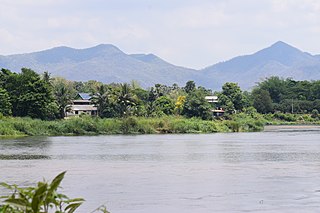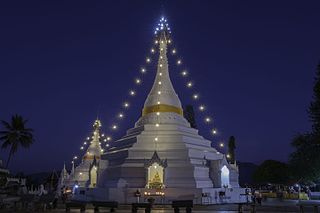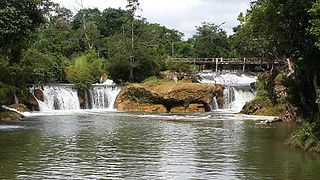
Tak is one of Thailand's seventy-seven provinces (changwat) and lies in lower northern Thailand. Neighbouring provinces are Mae Hong Son, Chiang Mai, Lamphun, Lampang, Sukhothai, Kamphaeng Phet, Nakhon Sawan, Uthai Thani and Kanchanaburi. The western edge of the province has a long boundary with Kayin State of Myanmar (Burma).

Mae Hong Son province, also spelled Maehongson, Mae Hong Sorn or Maehongsorn, is one of Thailand's seventy-six provinces (changwat). It lies in upper northern Thailand and is the westernmost province. Neighboring provinces are Shan State of Myanmar, Chiang Mai and Tak. To the west, the province borders Kayin State and Kayah State of Myanmar.

Kayah State is a state of Myanmar. Situated in eastern Myanmar, it is bounded on the north by Shan State, on the east by Thailand's Mae Hong Son Province, and on the south and west by Kayin State. It lies approximately between 18° 30′ and 19° 55′ north latitude and between 96° 50′ and 97° 50′ east longitude. The area is 11,670 km2 (4,510 sq mi). Its capital is Loikaw. The estimated population in 1998 was approximately 207,357, according to UNICEF. It is inhabited primarily by the Karenni ethnic group, also known as Red Karen or Kayah, a Sino-Tibetan people.

Myanmar is divided into twenty-one administrative subdivisions, which include 7 regions, 7 states, 1 union territory, 1 self-administered division, and 5 self-administered zones. Following is the table of government subdivisions and its organizational structure based on different regions, states, the union territory, the self-administered division, and the self-administered zones:

The Karen, also known as the Kayin, Kariang or Kawthoolese, are an ethnolinguistic group of Sino-Tibetan language–speaking peoples. The group as a whole is heterogeneous and disparate as many Karen ethnic groups do not associate or identify with each other culturally or linguistically. These Karen groups reside primarily in Kayin State, southern and southeastern Myanmar. The Karen, approximately five million people, account for approximately seven percent of the Burmese population. Many Karen have migrated to Thailand, having settled mostly on the Myanmar–Thailand border. A few Karen have settled in the Andaman and Nicobar Islands, India, and other Southeast Asian and East Asian countries.

Richardson Independent School District (RISD) is a school district based in Richardson, Texas (USA).

Bang Kho Laem is one of the 50 districts (khet) of Bangkok, Thailand. The incumbent district officer is Samita Xanthavanij. The district is bounded by Sathon, Yannawa, and across the Chao Phraya River, Rat Burana, Thon Buri and Khlong San districts.

The village of Bang Rachan was in the north of Ayutthaya, the old capital of Siam, the predecessor state of modern Thailand. Today their village is located in Khai Bang Rachan District of Sing Buri Province. The village is remembered in Thai popular history for its resistance against the Burmese invaders in the Burmese–Siamese War (1765–1767) that ended the Ayutthaya Kingdom.
The Nai Soi Community Learning Center (NSCLC) is a non-profit ecologically sustainable school for high school aged refugee children from Burma. The NSCLC is located in the village of Nai Soi, in Mae Hong Son Province, Thailand.

The Kayan are a sub-group of Red Karen, Tibeto-Burman ethnic minority of Myanmar (Burma). The Kayan consists of the following groups: Kayan Lahwi, Kayan Ka Khaung (Gekho), Kayan Lahta, Kayan Ka Ngan. Kayan Gebar, Kayan Kakhi and, sometimes, Bwe people (Kayaw). They are distinct from, and not to be confused with, the Kayan people of Borneo.
Insurgencies have been ongoing in Myanmar since 1948, the year the country, then known as Burma, gained independence from the United Kingdom. The conflict has largely been ethnic-based, with several ethnic armed groups fighting Myanmar's armed forces, the Tatmadaw, for self-determination. Despite numerous ceasefires and the creation of autonomous self-administered zones in 2008, many armed groups continue to call for independence, increased autonomy, or the federalisation of the country. The conflict is the world's longest ongoing civil war, having spanned more than seven decades.

The Shan State Army – South, also known simply as the Shan State Army, is the armed wing of the Restoration Council of Shan State (RCSS) and one of the largest insurgent groups in Myanmar (Burma). The SSA-S was led by Lieutenant General Yawd Serk until his resignation on 3 February 2014. Yawd Serk was reelected chairman of the RCSS shortly after his resignation and has remained chairman since.
The 'Bwe is an ethnic group present in Kayin State in Myanmar. Bwe are mostly populated at Thandaunggyi Township of Kayin (Karen) state.
Nai Soi is a small village located in Mae Hong Son Province in northern Thailand. The village is under the administration of the Thai authorities. Nai Soi is about three kilometers from the Ban Mai Nai Soi Karenni refugee camp. Nai Soi is about 20 kilometers from the town of Mae Hong Son, along a paved road accessible year-round. It is perhaps most well known for the refugee camp found there and for having the largest Karenni settlement of the three villages. Thai authorities view Ban Mai Nai Soi as a self-sustaining refugee camp.
The Karen Human Rights Group (KHRG) is a grassroots Karen-led human rights organisation, established in Karen State during 1992 and it is now operating across rural southeast Burma/Myanmar. With over twenty years of experience. KHRG is recognised internationally as an authority on major issues such as internal displacement, forced labour, landmines, conflict and land confiscation in southeast Burma/Myanmar. KHRG works directly with "rural villagers who are suffering abuses such as forced labor, systematic destruction of villagers and crops, forced relocations, extortion, looting, arbitrary detention, torture, sexual assault and summary executions." Most of these abuses were committed by soldiers and officials of the State Peace & Development Council (SPDC), Burma's previous ruling military junta. The organisation's goal is to support villagers in rural Burma, by helping them develop strategies to resist abuse and by translating their testimonies for worldwide distribution, accompanied by supporting photos and documentary evidence.

The Karenni Army is the armed wing of the Karenni National Progressive Party (KNPP), and operates in eastern Kayah State, Myanmar (Burma).

Mae La, Beh klaw ,(S'gaw Karen: မဲၣ်လးဒဲကဝီၤ, ဘဲကျီး) is a refugee camp in Thailand. It was established in 1984 in Tha Song Yang District, Tak Province in the Dawna Range area and houses 50,000 Karen refugees; the number continues to rise as of June 2019. Mae La is the largest refugee camp for Karen refugees in Thailand. Over 90% are the persecuted ethnic Karen. The camps are overseen and run by the Thailand Burma Border Consortium (TBBC), a union of 11 international non-governmental organizations that provide food, shelter and non food items to the Burmese refugees and displaced people.

Saharat Thai Doem was an administrative division of Thailand. It encompassed parts of the Shan States of British Burma annexed by the Thai government after the Japanese conquest of Burma.

The Pa-O National Army is a Pa-O insurgent group in Myanmar (Burma). It was established in 1949 and is the armed wing of the Pa-O National Organisation.
Karen Americans are Americans of full or partial Karen ancestry. They are a recent but rapidly growing immigrant population in the United States. Many Karen who emigrate are refugees as a result of violence in their homeland. Many come either from their traditional homeland of Kawthoolei in Myanmar or from refugee camps in Thailand. Minnesota was reported to have had more than 12,000 Karen residents in 2017, making it the state with the largest Karen community. Other states with significant populations are California, Texas, New York, and Indiana.













